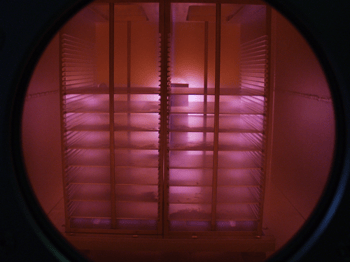Plasma Treatment Articles
Plasma Activation,
Plasma Treatment
|
3 min read
Topic:

Many manufacturers are using a primer to obtain good adhesion with water-based paints. Using primers may not be required and can often be eliminated—the best way to activate the surface before water-based paint application would be to use a plasma treatment. Plasma activation can increase the base material's surface energy just before the water-based paint is applied. Activation will open the bonds on the surface of the material in order for the paint to adhere and share those bonds. This surface preparation approach will create a powerful bond without the need for primers.
 Plasma activation is not the only type of treatment that can be implemented when using a plasma system. In manufacturing, there are often contaminants on a material's surface that can be removed using plasma treatment. Even if the material appears to be clean, trace organic contaminants, often called FM (foreign material), may be present. These foreign materials are removed during the plasma activation process, which creates a pristine surface before bonding. If the material has FM on the surface, it can hinder adhesion and result in low product quality.
Plasma activation is not the only type of treatment that can be implemented when using a plasma system. In manufacturing, there are often contaminants on a material's surface that can be removed using plasma treatment. Even if the material appears to be clean, trace organic contaminants, often called FM (foreign material), may be present. These foreign materials are removed during the plasma activation process, which creates a pristine surface before bonding. If the material has FM on the surface, it can hinder adhesion and result in low product quality.
Using plasma activation as a precursor instead of a primer in manufacturing eliminates the otherwise required primer drying time. This manufacturing change allows businesses to process/manufacture parts faster for greater production yield and throughput. Even though low-pressure plasma is often a batch process, the short process time and often large batch processing capability allow the plasma process not to be the bottleneck like a primer would be. Even if the treated parts cannot be processed immediately downstream because of unforeseen factors, the treatment may be treated again to ensure optimal product results.
When applying water-based paints, the base materials have a specific surface energy requirement for the paint to bond to the material properly. The surface energy, therefore, the bonding readiness of each material will vary slightly but will be approximately in the same range. Many materials do not start at the required surface energy. When there is a need to increase the surface energy, it can be improved using plasma treatment, specifically plasma activation. When there is a basic understanding of the base material composition, plasma experts at Thierry can suggest process parameters to ensure the optimum surface energy is achieved every time. Having the right surface energy will ensure the best bond possible when applying the water-based paints to any material.
Plasma treatment is better than using a primer because, during a plasma activation, the plasma also cleans the surface and reduces surface contamination risk. When a primer is applied, there is a risk for the surface to be contaminated by extraneous foreign material (FM) or even FM present in the primer itself. Plasma activation usually is done in a chamber, an enclosed environment where the risk of surface contamination is minimal.
A great property of plasma is that there is no introduction of new material to the manufacturing process or the base material. There is also no need to change the properties of the paint (viscosity or thickness). The plasma treatment merely is opening bonds on the surface of the material so that the surface will readily accept a new bond with the paint applied to the surface. This allows manufacturers to keep their initially specified paint thickness and viscosity.
 Often, oil-based paints do not require an increase in surface energy of the base materials. However, oil-based paints are challenging to produce and require harmful chemicals in the manufacturing process. The European Union (EU) has moved to eliminate all oil-based paints used in manufacturing, especially in the auto industry. This EU mandate has caused a shift to use water-based paints with the aid of plasma technology instead of a primer to protect the environment. This change has opened many eyes to plasma technology that has been embraced more in Europe than in North America. In comparison, water-based paints can save money and improve quality over the solvent-based paints.
Often, oil-based paints do not require an increase in surface energy of the base materials. However, oil-based paints are challenging to produce and require harmful chemicals in the manufacturing process. The European Union (EU) has moved to eliminate all oil-based paints used in manufacturing, especially in the auto industry. This EU mandate has caused a shift to use water-based paints with the aid of plasma technology instead of a primer to protect the environment. This change has opened many eyes to plasma technology that has been embraced more in Europe than in North America. In comparison, water-based paints can save money and improve quality over the solvent-based paints.
Using plasma treatment as a precursor in the manufacturing process before applying water-based paints has excellent advantages.
To learn more about surface activation and water-based paint adhesion in the manufacturing process, please read our article titled "Manufacturer’s Surface Activation Guide for Improved Adhesion."
Plasma: +1 (248) 761 9253
Distribution: +1 (248) 549 8600
Fax: +1 (248) 549 3533
info@thierry-corp.com
Comments